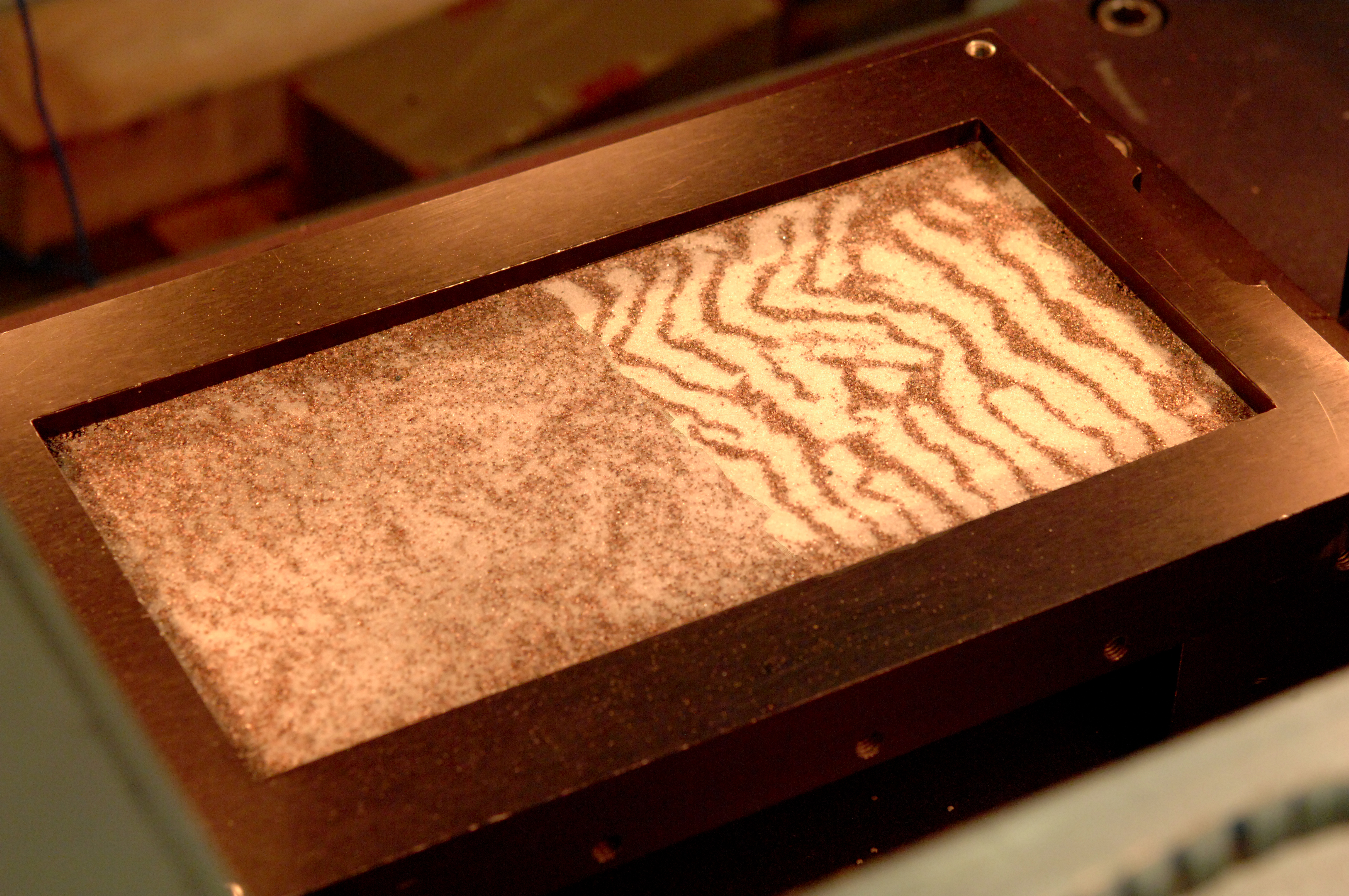with C. Lozano and T. Mullin
(3) Instabilities in collapsible channels
A collapsible channels is a channel, which has two parallel planar walls with a segment of one of the walls replaced with an elastic membrane. When a fluid is driven sufficiently rapidly through such channel, the system becomes unstable, leading to a large viraity of self-excited oscillations in both the fluid and the elastic wall. The collapsible channel is a 2D model of the Starling resistor. Therefore, it is believed that these instabilities are related to physiological phenomenon, such as Korotkov sounds during blood pressure measurement and wheezing in the lungs.
(1) Viscous fingering in elastic-walled Hele-Shaw cells
The developement of viscous fingering in Hele-Shaw cells is a classical and widely studied fluid mechanical instability. When air is injected in a viscous fluid layer that fills the narrow gap between two rigid, parallel plates, the radially expending air bubble that displace the viscous fluid tends to be unstable to non-axisymmetric perturbations, resulting in complex highly branched finger-like structures at the interface. However, if the upper bounding plate of the Hele-Shaw cell is replaced by a latex membrane, the onset of fingering can be delayed considerably, and even when it develops the instability has a fundametally different shape. Furthermore, when thinner polyethylene sheets are used as elastic walls, the membrane's propensity to wrinkle increases, and both viscous fingering and sheet buckling are possible.
Top view of the experimental fingering patterns in (a) the rigid cell and (b, c) the elastic-walled cell with a latex membrane of thickness 0.33 mm and Young's modulus 1.44 MPa (d) the elastic-walled cell with a polyethylene membrane of thickness 0.03 mm and Young's modulus 3.7 GPa, in which a growing air bubble displaces 1000 cSt silicone oil at a constant injection flow rate (a, b) 145 ml/min and (c, d) 1.25 l/min. The initial depth of the cell and its radius were 0.57 mm and 15 cm, respectively. The deformation of the latex membrane remained axisymmetric even when the air-liquid interface developed large-amplitude fingers, whereas the sheet wrinkling is evident in the experiments with polyethylene.
(a)
(b)
(c)
(d)
Publications
D. Pihler-Puzović, P. Illien, M. Heil & A. Juel (2012).
Suppression of complex fingerlike patterns at the interface
between air and the viscous fluid by elastic membranes.
Phys. Rev. Lett., 108, 074502 (editor's choice).
D. Pihler-Puzović, R. Périllat, M. Russell, A. Juel
& M. Heil (2013).
Modelling the suppression of viscous fingering in
elastic-walled Hele-Shaw cell.
J. Fluid Mech., 731, 162-183.
D. Pihler-Puzović, A. Juel & M. Heil (2014).
The interaction between viscous fingering and wrinkling
in elastic-walled Hele-Shaw cells.
Phys. Fluids, 26, 022102.
(2) Granular segregation in horizontally shaken monolayers
Segregation occurs when a mixture of different sized particles demixes under flow to form clusters of the constituent components. It is important in problems ranging in scale from the industrial to the geological, and provides a striking example of emergence of order in a complex system.
Starling resistor

Here, the lighter particles are glass beads of 0.35 mm diameter and the darker particles are 0.11 mm teardrop shaped carborundum. A mixture was placed in a one-particle deep layer on a (18 cm x 9 cm) horizontal tray which was oscillated in the longitudinal direction. The particles segregated forming a zebra-stripe pattern, with stripes primarily oriented perpendicular to the shaking direction. A composite image of the initial mixture (left-half) and after two minutes of shaking (right-half) is shown to give an impression of the evolution of the pattern.
Publications
D. Pihler-Puzović & T. Mullin (2013).
The timescales of granular segregation in horizontally shaken monolayers.
Proc. R. Soc. A, 469, 2157, 20130203.
with A. Juel and M. Heil
Publications
D. Pihler-Puzović & T. J. Pedley (2013).
Stability of high-Reynolds-number flow in a collapsible channel.
J. Fluid Mech., 714, 536-561.
D. Pihler-Puzović & T. J. Pedley (2014).
Flutter in a quasi-one-dimensional model of a collapsible channel.
Proc. R. Soc. A, 470, 2166, 20140015.
T. J. Pedley & D. Pihler-Puzović (2015).
Flow and oscillations in collapsible tubes: physiological applications and low-dimesional models.
IUTAM Symposium: Deformable tubes and channels, Sadhana, 40, 3, 891-909.
